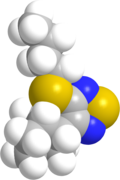 | |
 | |
| Clinical data | |
|---|---|
| Other names | (S)-3-[4-(butylthio)-1,2,5-thiadiazol-3-yl]quinuclidine |
| ATC code |
|
| Identifiers | |
| |
| CAS Number | |
| PubChem CID | |
| ChemSpider | |
| UNII | |
| ChEMBL | |
| CompTox Dashboard (EPA) | |
| Chemical and physical data | |
| Formula | C13H21N3S2 |
| Molar mass | 283.45 g·mol−1 |
| 3D model (JSmol) | |
| |
| |
Vedaclidine (INN,[1]: 180 codenamed LY-297,802, NNC 11-1053) is an experimental analgesic drug which acts as a mixed agonist–antagonist at muscarinic acetylcholine receptors, being a potent and selective agonist for the M1 and M4 subtypes, yet an antagonist at the M2, M3 and M5 subtypes.[2][3] It is orally active and an effective analgesic over 3× the potency of morphine, with side effects such as salivation and tremor only occurring at many times the effective analgesic dose.[4][5][6] Human trials showed little potential for development of dependence or abuse,[7] and research is continuing into possible clinical application in the treatment of neuropathic pain and cancer pain relief.[8]